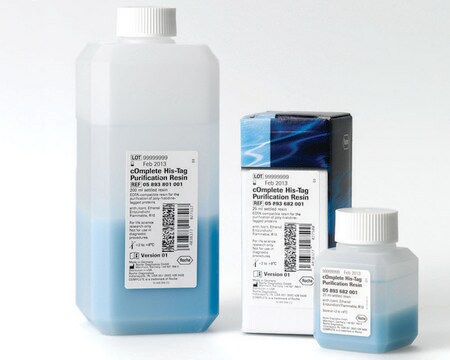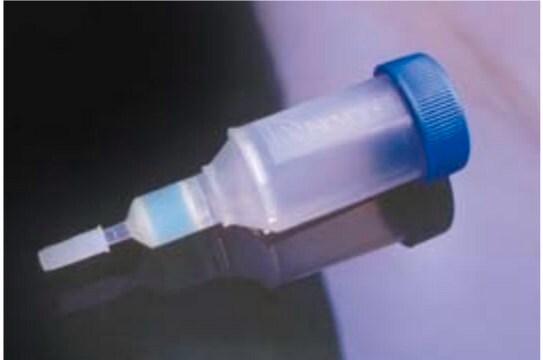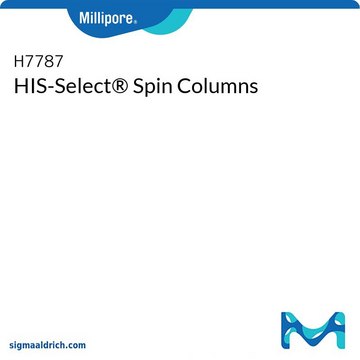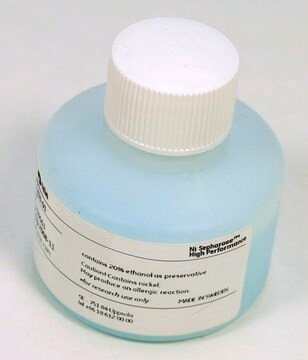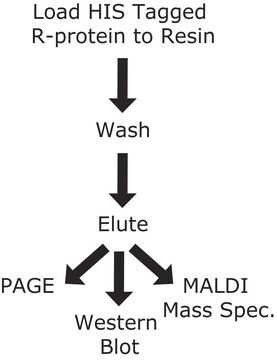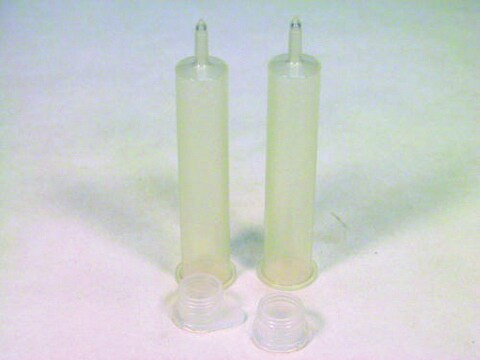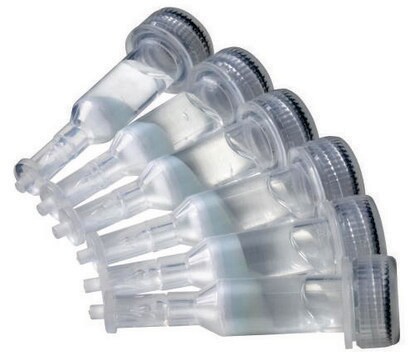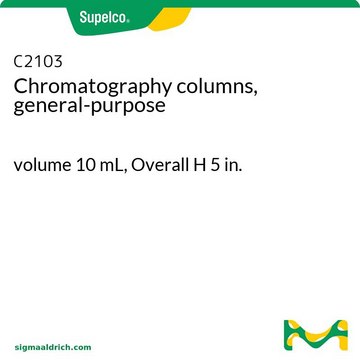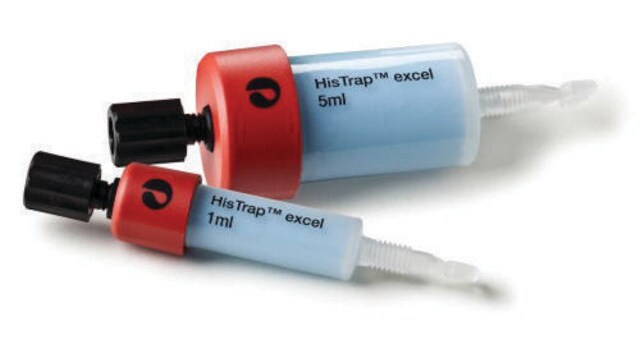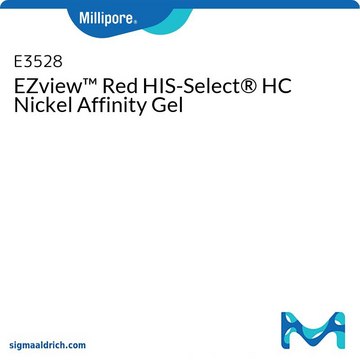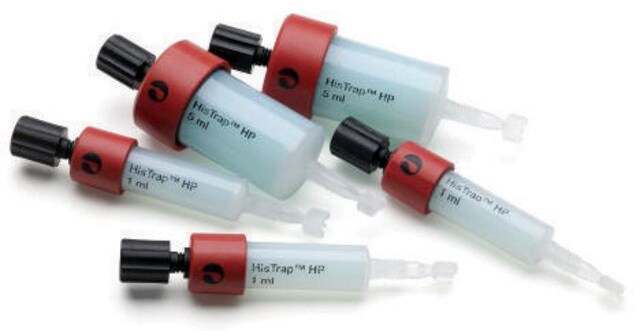COHISC-RO
Roche
cOmplete™ His-Tag Purification Column
Prepacked, ready-to-use chromatography column
Sign Into View Organizational & Contract Pricing
All Photos(4)
About This Item
UNSPSC Code:
41116133
NACRES:
NA.21
Recommended Products
packaging
pkg of 5 x 1 mL (columns (06781543001))
pkg of 5 mL (column (06781535001))
manufacturer/tradename
Roche
parameter
1,420 cm/hr max. flow rate
capacity
≥40 mg/mL, resin binding capacity
storage temp.
2-8°C
General description
The most common technique in affinity purification of proteins involves engineering a sequence of 6 to 14 histidines into the N- or C-terminal (or even on an exposed loop) of the protein. Such polyhistidine stretches bind strongly to divalent metal ions such as nickel and cobalt. This effect can be used to separate proteins. Metal ions can be immobilized on a matrix using a chelator, which still allows the ion to interfere with the polyhistidine tag of the protein. When these his-tagged proteins are passed through a column containing immobilized metal ions, the proteins bind via the tag to the column. Nearly all untagged proteins pass through the column. The protein is released from the column by elution with either imidazole, which competes with the polyhistidine tag for binding to the column, or by a decrease in pH, which decreases the affinity of the tag for the resin. While this procedure is generally used for the purification of recombinant proteins with an engineered affinity tag, it can also be used for natural proteins with an inherent affinity for divalent cations.
Features and Benefits
cOmplete His-Tag Purification Columns are available in 2 sizes and prepacked with cOmplete His-Tag Purification Resin. The cOmplete His-Tag Purification Resin is an innovative high-capacity IMAC matrix (Immobilized Metal Affinity Chromatography) for convenient single-step purifications of His-tagged proteins from total lysates. Roche′s propriety nickel-chelate chemistry ensures extraordinary compatibility with commonly used reducing agents such as DTT, chelating metalloprotease inhibitors such as EDTA, and a wide range of buffer substances and salt conditions. The wide choice of compatible ingredients allows optimization of buffers for maximum protein stability and solubility.
cOmplete His-Tag Purification Columns are fully compatible with standard purification systems such as ÄKTA Systems (Cytiva).
cOmplete His-Tag Purification Columns are fully compatible with standard purification systems such as ÄKTA Systems (Cytiva).
- Use the buffer conditions best suited to your protein
- Repeatedly obtain highly pure protein
- Protect your protein from toxic nickel
- Work in a safe and eco-friendly environment
Packaging
- 06781535001 (5 mL column; 1 column containing 5 ml of cOmplete His-Tag Purification Resin)
- 06781543001 (5 x 1 mL columns; 5 columns containing 1 ml of cOmplete His-Tag Purification Resin)
Compatibility
Compatibility for long term storage: 20% ethanol, pH 4.0 to pH 9.0
Compatibility during chromatography: The resin is compatible with 10mM EDTA, 10mM DTT during the purification (1 hour incubation), 6M guanidinium-HCl, 8M urea, pH 2.0 to pH 14.0.
Compatibility during cleaning: 4% SDS Form cOmplete His-Tag Purification Resin filled in columns, pre-charged with Ni2+ stored in 20% ethanol.
Compatibility during chromatography: The resin is compatible with 10mM EDTA, 10mM DTT during the purification (1 hour incubation), 6M guanidinium-HCl, 8M urea, pH 2.0 to pH 14.0.
Compatibility during cleaning: 4% SDS Form cOmplete His-Tag Purification Resin filled in columns, pre-charged with Ni2+ stored in 20% ethanol.
Other Notes
Recommended volumetric flow rate: 5 ml column (06 781 535 001): 2.5 to 10 ml/minute
1 ml column (06 781 543 001): 0.5 to 2.0 ml/minute
The volumetric flow rate is a function of the column′s cross section.
Recommended imidazole concentration for load/wash: Nonspecific binding of proteins without a His-tag is low.
Use up to 5 mM imidazole in load and/or wash buffers.
If establishing a new assay for purification of His-tag proteins with cOmplete His-Tag Purification Columns do not use imidazole. If, e.g., the purity of the His-tag protein needs to be improved following this first step, use imidazole in a final concentration of up to 5mM in a second step.
Recommended imidazole concentration for elution: Up to 500mM
Please note:
In contrast to other available resins, bound His-tagged protein typically elutes from cOmplete His-Tag Purification Columns with a lower imidazole concentration, e.g., 25 to 45mM.
Binding capacity
The binding capacity of the resin to various types of proteins may vary according to the protein characteristics such as the size of the protein.
cOmplete His-Tag Purification Columns bind with a high specificity to the polyhistidine-tagged protein. As a consequence, the binding kinetics may appear to be different when compared to conventional metal chelate matrices. Full capacity of cOmplete His-Tag Purification Columns can be achieved by allowing more time for the protein to bind to the resin by lowering the flow rate during the chromatography purification procedure.
1 ml column (06 781 543 001): 0.5 to 2.0 ml/minute
The volumetric flow rate is a function of the column′s cross section.
Recommended imidazole concentration for load/wash: Nonspecific binding of proteins without a His-tag is low.
Use up to 5 mM imidazole in load and/or wash buffers.
If establishing a new assay for purification of His-tag proteins with cOmplete His-Tag Purification Columns do not use imidazole. If, e.g., the purity of the His-tag protein needs to be improved following this first step, use imidazole in a final concentration of up to 5mM in a second step.
Recommended imidazole concentration for elution: Up to 500mM
Please note:
In contrast to other available resins, bound His-tagged protein typically elutes from cOmplete His-Tag Purification Columns with a lower imidazole concentration, e.g., 25 to 45mM.
Binding capacity
The binding capacity of the resin to various types of proteins may vary according to the protein characteristics such as the size of the protein.
cOmplete His-Tag Purification Columns bind with a high specificity to the polyhistidine-tagged protein. As a consequence, the binding kinetics may appear to be different when compared to conventional metal chelate matrices. Full capacity of cOmplete His-Tag Purification Columns can be achieved by allowing more time for the protein to bind to the resin by lowering the flow rate during the chromatography purification procedure.
For life science research only. Not for use in diagnostic procedures.
Legal Information
cOmplete is a trademark of Roche
Signal Word
Warning
Hazard Statements
Precautionary Statements
Hazard Classifications
Carc. 2 - Eye Irrit. 2 - Flam. Liq. 3 - Skin Sens. 1
Storage Class Code
3 - Flammable liquids
WGK
WGK 1
Flash Point(F)
93.2 °F
Flash Point(C)
34 °C
Choose from one of the most recent versions:
Already Own This Product?
Find documentation for the products that you have recently purchased in the Document Library.
Customers Also Viewed
Articles
Get maximum protection after protein isolation by using protease and phosphatase inhibitor cocktail tablets from Roche.
Protocols
cOmplete™ His-Tag Purification Column Protocol & Troubleshooting
Our team of scientists has experience in all areas of research including Life Science, Material Science, Chemical Synthesis, Chromatography, Analytical and many others.
Contact Technical Service